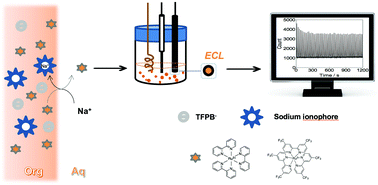Ruthenium bipyridine complexes as electrochemiluminescent transducers for ionophore-based ion-selective detection†
Abstract
We report here a method to determine target ion concentrations (with Na+ as a model) based on ionophores and electrochemiluminescence (ECL). Ruthenium bipyridine complexes were released from thin polymeric films (plasticized poly(vinyl chloride) also containing a sodium ionophore) into the sample solution following an explicit ion-exchange process (between Na+ and the ruthenium complex). Two signal transducers, tris(2,2′-(pCF3)bipyridine)ruthenium(II) (Ru(p-CF3-bpy)32+) and tris(2,2′-bipyridyl)dichlororuthenium(II) (Ru(bpy)32+), were examined using the sensing film, with the latter providing a more sensitive detection range (ca. 1 to 100 μM) than that of the more hydrophobic one (0.01 to 1 mM). While the ionophore (Na+ ionophore X) offered excellent selectivity to the method, the ruthenium complexes made the measurements independent of the sample pH. Furthermore for complex biological samples such as blood serum, an indirect approach of measuring the ECL of the remaining ruthenium complexes helps avoid background matrix interference to the ECL production at the working electrode, making the ECL method more attractive for real complex samples.



 Please wait while we load your content...
Please wait while we load your content...